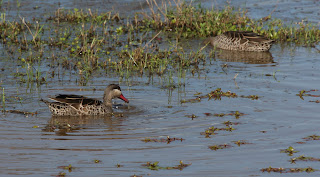We had a pre-booked afternoon game drive, scheduled for 2 hours from 3:30. First-up Peter asked if we wanted to visit the Chimpanzee sanctuary, which we declined. I explained that I hoped we weren’t too awkward but actually we’d just like to get out there and see what there was to see.
I think Peter felt he was in for a long afternoon when the first thing we asked him to stop for was a
Crowned Lapwing:

We later found out that answering yes to the above question, means you get a three stop tour, the Chimps, the Hippos and a popular watering hole, which is what almost all their visitors want. Being awkward of course we said no, we would like to see as many birds as possible and therefore visit distinctive habitats on the sanctuary.
Peter therefore decided a route that would take us first to a swampy area. On the way we spotted a
Wahlberg’s Eagle soaring (distant and from a car with the engine running!):

A brief interlude for some of our non-feathered friends from the drive, this is a Bush Buck:

A view across open ground - the skies in Africa are always so big:

I believe this is an Impala:

As we approached the swampy area, we encountered a small group of
Helmeted Guineafowl:

and a
Brown Parrot:

We did see a Black-shouldered Kite on high and in the distance a few Grey Crowned Cranes but I didn’t even manage a record shot of the latter…. we have to go back then…
As we were stood looing around in the modified bus (think camper van with a roof that lifts onto struts so that you can stand-up), a pair of Warthogs approached, and with them a new species for us, the
Red-bellied Oxpecker:

While we watched them the Oxpecker obviously wanted to move on as it pecked its host in the eye causing it to run, which was actually really quite funny.
We approached the swampy area to get closer to the birds, including an
African Spoonbill:
 Green Sandpiper
Green Sandpiper:
 Red-billed Teal
Red-billed Teal:
 Yellow-billed Duck
Yellow-billed Duck:
 Common Greenshank
Common Greenshank:

We also spotted a Malachite Kingfisher but they are very small birds and this one was at quite a distance. I was still panning round, taking pictures and identifying species when suddenly everything erupted, it quickly became apparent why, as this
African Fish Eagle cruised past, perching on a tree in the middle distance:

As you can see it virtually cleared the area:

We followed the track as it headed past the swampy area, seeing first a
Lammergeier:

Then,
Ruppell’s Griffon Vulture:

And getting close to a
Hamerkop:

A final encounter as the swampy area, was this huge bull African Elephant:

Next we stopped at a Hippo hide. The fact there’s a hide for Hippopotamuses shows the conditions are not entirely wild. The Hippos barely show themselves, as they are confined to one area as a consequence of the surrounding habitat and have a constant stream of humans coming to see them, hence our limited views:

We spotted a new bird near the hide though, a
Common Bulbul:

Back on the drive a large bird being mobbed by Starlings, turned out to be an
African Harrier Hawk:

The afternoon was going very well and Peter decided to head-out to the far side of the sanctuary to check out some different habitat. On the way we passed a building being used by both
Speckled Pigeons and
Vitelline Masked Weavers (apologies for the light, distance, vehicle vibration, etc):

Heading on we caught a fleeting glimpse of
African Hoopoe and brief views of
Yellow-neck Spurfowl before seeing this
Red-capped Lark:

Labels: bird identification, bird photography, bird watching, birding, birding in Kenya, british birds, garden birds, garden for nature, walking





























































